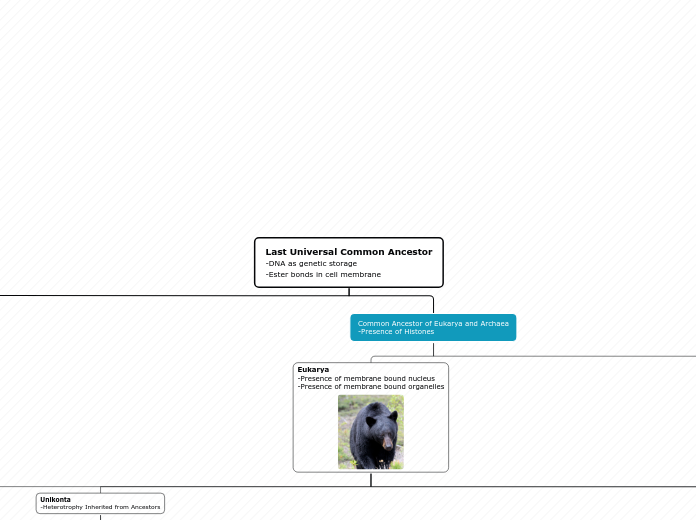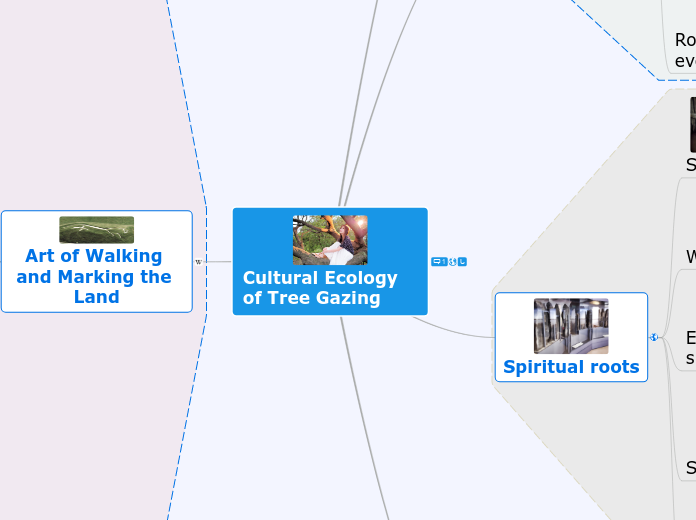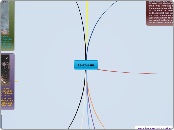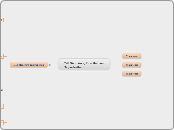Last Universal Common Ancestor
-DNA as genetic storage
-Ester bonds in cell membrane
Common Ancestor of Eukarya and Archaea
-Presence of Histones
Archaea
-Ether bonds in cell membrane
Eukarya
-Presence of membrane bound nucleus
-Presence of membrane bound organelles
Excavata
-Feeding Groove
-Secondary Plastids
SAR Clade
Rhizaria
-Filose Pseudopodia
Foraminiferas
Radiolarians
Common Ancestor of Stramenopila & Alveolata
Alveolata
-Mebranous vacuoles
-Secondary Plastids
-Dinoflagellates have secondary OR tertiary plastids
Stramenopila
-Tripartite flagellar hairs
-Secondary Plastids
Kelp
Diatoms
Unikonta
-Heterotrophy Inherited from Ancestors
Amebozoa
-Pseudopodia that extend like tubes or flat lobes
-Slime molds
Opisthokonta
-Singular Posterior Flagellum on Swimming Cells
-Absorptive Heterotrophy
Kingdom Fungi
-Fly Agaric & Black Bread Mold
- Multicellularity
- Chitin Cell Wall
-Zygotic Life Cycle with Dikaryotic Stage
Common Ancestor of Choanoflagelletes & Animals
Kingdom Animalia
- Multicellularity
- Mobility
- Complex Organ Systems
- Gametic Life Cycle
Eumetazoa
-Tissues
Cnideria
-Diploblasty
-Radial Symmetry
Anthozoa
-Usually Only Polyp
Medusozoa
Scyphozoa
-Usually Only Medusa
Hydrozoa
-Polyp & Medusa
Bilateria
-Triploblasty
-Bilateral Symmetry
-Cephalization
Protostomia
-Spiral & Determinate Cleavage
-Blastopore Becomes Mouth
Ecdysozoa
-Ecdysis
-Metamorphosis (most)
Nematoda
-Free-living & Parasitic
-Complete Digestive Tract
-Cuticle
-Pseudocoelom
Arthropoda
-Chesapeake Blue Crab
-"Jointed Foot"
-Segmented with Exoskeleton Made of Chitin
-Complete Digestive Tract
-Open Circulatory System
Chelicerates
- Cephalothorax & Abdomen
- 4 Pairs of Walking Legs, Pedipalps, & Chelicerae
Pancrustaceans
Hexapoda
-Have Six Legs
-Insects
-Many Have Wings
-Head, Thorax, & Abdomen
Crustaceans
-Cephalothorax
Lophotrochozoa
-Lophophore and/or Trocophore Larvae
Common Ancestor of Mullusca & Annelida
Mullusca
-Soft Bodied
-Organ Systems
-Mantle, Foot, & Visceral Mass
-Coelomates
Bivalvia
-Two Part Shells
Cephalopoda
-Reduced or Absent Shells
-Closed Circulatory System
Gastropoda
Annelida
-Segmented Worms
-Closed Circulatory System
-Complete Digestive Tract
Platyhelminthes
-Acoelomates
-Incomplete Digestive Tract
-No Respiratory or Circulatory System
Tapeworms
-Parasitic
-No Digestive System
Trematodes
-Parasitic
Free-Living Rhabditophorans
Deuterosomia
-Radial & Indeterminate Cleavage
-Blastophore Becomes Anus
Echinodermata
-Giant Sea Star
- "Spiny Skin"
-Water Vascular System
-No Brain
-Complete Digestive System
-Adults are radial symmetrical; larvae are bilaterally symmetrical
Holothuroidea
-Sea Cucumbers
Asteroidea
-Sea Stars
Echinoidea
-Sea Urchins
-Sand Dollars
Ophiuroidea
-Brittle Stars
Chordata
-American Black Bear
-Notochord
-Dorsal Nerve Cord
-Endostyle
-Pharyngeal Slits
Cephalocordata
Common Ancestor of Vertebrates & Urochordates
Urochordata
Vertebrates
-Cranium
-Vertebral Column
Agnathans
(Clyclostoma)
Pacific Hagfish
Petromyzontida
-Lampreys
Gnathostomes
-Jaws
-Bony Skeleton
Osteichthyes
-Lungs/Lung Derivatives
Lobe-Finned Fishes
-Skeleton Extends into Fins
Coelocanths
Common Ancestor of Lungfishes & Tetrapods
Lungfishes
Tetrapods
-Four Limbs with Digits
Amniotes
-Amniotic Eggs
Reptiles
Archosaurs
Common Ancestor of Birds & Crocodiles
Crocodilians
Birds
Turtles
Lepidosaurs
-Snakes
-Lizards
Mammalia
-Hair
-Milk
Monotremes
-Egg Laying Mammals
Common Ancestor of Marsupials & Eutherians
Marsupials
Eutherians
Amphibia
-Non-Amniotic Eggs
Ray-Finned Fishes
Chondrichthyes
-Bony Skeleton is Lost
-Cartilaginous Skeleton in Extant Species
Porifera
-Asymmetry
-No Tissues
Choanoflagellates
Archaeplastida
-Primary Plastids
Bacteria
-Presence of peptidoglycan in cell wall









